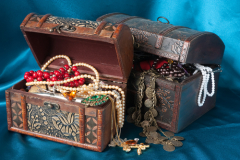
In 1827, the artist Tropinin painted a portrait of the brilliant poet Alexander Pushkin. He posed for him with some deliberate carelessness – in a dressing gown. But even at home, Alexander Sergeevich rarely took off his favorite rings from his fingers. And in this portrait we see the poet's right hand holding a stack of paper: on the thumb – a ring with a green stone similar to an emerald, and on the index finger – a ring of a twisted shape.
Pushkin took all sorts of talismans quite seriously, and he had no shortage of them throughout his life. One of the most famous is a signet ring with a carnelian. The trinket was given to the Russian genius by E.K. Vorontsova before his departure from Odessa to Mikhailovskaya exile. Pushkin soon thanked the giver with the poem “Talisman”.
L. Zvyagintsev in his essay “Talismanic Rings” wrote that Vorontsova herself wore a second, identical ring. She used it to seal her love letters to the poet. And her gift to Pushkin was exhibited at an exhibition in St. Petersburg in 1880. One of the visitors left the following description of the ring: “This is a large gold ring of a twisted shape with a large red stone and an oriental inscription carved on it.” That is, in Tropinin's portrait, Pushkin is most likely depicted with a talisman from Vorontsova. It's just that the stone with the inscription, in all likelihood, turned the other way.
In the portrait by Vasily Tropinin, the poet is depicted with his talisman rings
V. P. Annenkov claimed that Alexander Sergeevich “…even associated his talent with the fate of a ring, covered with some cabalistic signs and carefully kept by him.” (“Materials for the biography of A. S. Pushkin”, 1855).
Before his death, Pushkin gave this ring to Vasily Zhukovsky. The “heir” also treasured the ring and wore it almost constantly, next to his wedding ring. Later, Zhukovsky's son gave the talisman to Ivan Turgenev. Wanting to strengthen the tradition of passing the ring to the best continuer of Pushkin's traditions, Turgenev asked after his death to present it to Count L. N. Tolstoy, but Pauline Viardot took the ring to the Pushkin Museum of the Alexander Lyceum. Several years later, it was stolen from there.
In the 19th century, choosing symbolic stones for oneself was fashionable. The hobby captured the entire nobility of Moscow and St. Petersburg. Books describing the magical properties of minerals were called lapidariums and were sold in impressive print runs for that time. People often treated jewelry with natural stones as talismans, not as decorations. And Pushkin was no exception. Legends circulated about the poet's rings during his lifetime, and after his death, everything was shrouded in a thick haze of mysticism.
The poet acquired his very first signet ring during his association with the Masonic “Green Lamp”. Each member of the group had a seal in the form of an antique lamp. All internal mail was sent under this mark. Only one letter from Pushkin, sealed with a Masonic signet, has survived. But where the ring itself went later, what metal it was made of, and whether Pushkin considered it a talisman is unknown.
He also never parted with another ring – a gold ring with a square emerald. The story of how it came to the poet is shrouded in darkness. Perhaps he ordered it for himself or bought it. This ring is also visible in Tropinin’s portrait and, like the carnelian one, was honored to be called a talisman. Some researchers of Pushkin’s work even believe that the poem “Keep me, my talisman” is dedicated to this ring, and not to the gift from E.K. Vorontsova.
Moreover, it suited Pushkin, born under the zodiac sign of Gemini, much better than carnelian. After all, emerald has long been considered a stone of poets and artists, a kind of “generator” of inspiration. It was “inherited” by V. I. Dahl. The future author of the “Explanatory Dictionary” was given it by the poet's widow Natalya Nikolaevna. Now the emerald ring is kept in the Pushkin Apartment Museum on Moika, 12.
A thin ring with a pale carnelian, on which three cherubs are depicted getting into a boat, passed into the family of the princes Volkonsky. In 1915, the grandson of Princess M.N. Volkonskaya gave it to the Pushkin House with an accompanying note of the following content: “I ask you to accept and give as a gift to the Pushkin House of the Imperial Academy of Sciences the enclosed ring, which belonged to A.S. Pushkin. It was entered into a lottery, played out in the house of N.N. Raevsky, and was won by my grandmother, Maria Nikolaevna, the wife of a Decembrist, and was given to me by my father, Prince Sergius Volkonsky, when I graduated from high school… in 1880.”
Pushkin believed in the turquoise ring he received from V.P. Nashchokin as protection from violent death. Shortly before the duel, he gave it to Danzas, his comrade from the Lyceum and future second. Danzas subsequently lost it, which he regretted more than once.
“My vile turquoise” – this is what Pushkin called the bracelet, decorated, as it turned out later, not with turquoise, but with green jasper. He presented it as a gift to Ekaterina Ushakova, but the young lady's jealous fiancé mercilessly broke the trinket. After the poet's death, Ushakova's father ordered his initials to be carved on the back of the stone and inserted into a ring. The further fate of Pushkin's jasper is unclear.
Pushkin may have had other talismanic ornaments, but no information about them has survived.





